The Paul Sandby Exhibition
An Unknown Folly in Cardiff?
From time to time I like to describe myself as an architectural historian. After all I’ve written several well-received books on architectural history, all aimed at widening the interest base in the subject rather than seeking academic accolades. This would have been impossible anyway in my preferred subject; follies being seen as meretricious and flippant compared to great church or state architecture.
Unlike many scholars, I’m happy to admit to my failings. I don’t want disciples and I don’t expect my work to be followed slavishly and unquestioningly. It would make me uncomfortable.
All this is by way of making excuses to admit that I was not familiar with the work of Paul Sandby, the artist who is the subject of a new exhibition at the Royal Academy. I was not aware he had produced such an impressive body of detailed architectural and landscape watercolours, throughout the second half of the eighteenth century.
He started work as a draughtsman and map-maker, and this early precision stayed with him throughout his life. Although a number of his works are described as capriccios — they showed an idealised or imaginary landscape — the buildings are rendered with the formality of a measured drawing.
Look at his watercolour of The North Terrace, Windsor Castle, Looking West, c.1765 and admire the razor-sharp accuracy of the cut stone.

This was clearly done to commission, unlike this windy view in a very different style of the artist’s own studio, an elegant classical pavilion perhaps designed by his elder brother Thomas, built at the end of his garden in St. George’s Row, somewhere in London. Now Thomas Sandby I had heard of in the world of follies — he was nicknamed Tommy Sandbank for his failure to build effective dams.

These crisp images are supplied by the Royal Academy’s PR department, but I saw drawings, etchings and sketches that interested me much more. Here alas the image quality plummets, because these were snapped at the exhibition with my iPhone (ancient model) so the quality is what Von quaintly refers to as SWILL — you can just about See What It Looks Like.
Firstly, Paul’s brother Thomas’s design for the grotto which still exists at Virginia Water. Two images, one a water colour, one an etching, the etching showing the cascade and a Chinese bridge (which I didn’t know about).


And here is a lovely picture of a folly high over the countryside — The seat near the Terrace at Windsor with a view of the adjacent country to the north-east, c.1765. It is a witty, happy painting of some rumpty-tumpty going on at the back of the eyecatcher — for that is what this seat is. You can see the back of the pediment, so there must be a seat in the grandly decorated front façade overlooking the vista, with the two penthouses at the back for courting couples.

Now this really does intrigue me. If it had been situated somewhere other than Windsor, then you could have come back with me to a dark December afternoon in the 1970s, and just picture stumbling across this ruined folly, sans wooden seats at the back, stucco peeling off the façade, buried in a dank, wet overgrown wood on a remote hillside with no remaining vestige of a view. And here it is in its pomp, being put to the use I always suspected it was designed for. The artist clearly had a sense of humour. I don’t know Windsor well enough to say if the seat still stands, but I’ll happily bet the view is now obscured by trees. Which is probably as it should be, seeing that you’d be looking out over Langley and Slough.
There’s plenty more to see and enjoy at the exhibition — Sandby’s bills to Sir Watkin Williams-Wynn for travelling up to Wynnstay make interesting reading — but my final discovery was this stunning little Gothick castellated Tower of the Winds, apparently built inside the city walls of Cardiff. Sorry it’s such a rotten picture, but the item was very small in the painting. Was this ever built? Could it still be there? Was this another fantastic, wishful embellishment by Sandby?

Sadly I think the last explanation is the most likely. I very much doubt if it still exists, if it ever did.
Paul Sandby (1731 – 1809): Picturing Britain, A Bicentenary Exhibition 13 March 2010 to 13 June 2010 at the Royal Academy, Piccadilly, London

